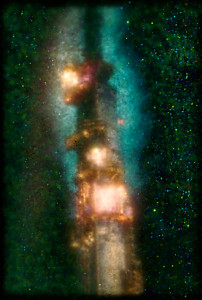RADICAL COLOR
Curated by Jon Feinstein
Newspace Center for Photography, Portland, OR
Exhibition Dates: February 6 – March 30, 2015
Opening Reception: Friday, February 6, 6-9pm

Featured on:
The Huffington Post
Feature Shoot
HAFNY Group Show 44: Radical Color
Essay by Jon Feinstein:
Color photography and its relationship to the art world has endured a charged and tenuous past. Nearly 50 years ago, William Eggleston, Helen Levitt, William Christenberry, Stephen Shore and Joel Sternfeld, propelled by the support of John Szarkowski and the Museum of Modern Art, helped encourage a larger embrace of color photography within the greater dialogue of fine art. While early 20th century photographers like Edward Steichen made significant moves to explore color’s experimental possibilities, Shore’s generation may have been the first to push it into wider acceptance beyond its traditional place as a commercial application. Their approach was largely descriptive, using color as a means of representing the world beyond black and white’s limited abilities.
Color’s next generation, which included Jeff Wall, Rineke Dijkstra, Thomas Ruff and many others working in the late 1980s onward, introduced a new level of excitement, one whose engagement with art history and conceptual art helped further enable a conversation with the photography-resistant, fine art types. In many cases, these photographers challenged earlier generations’ use of color as factual description, and photography’s ability to accurately represent truth.
Using these two generations as a reference point, Radical Color looks to how contemporary art photographers have expanded upon, and shattered these previous conventions, creating work with unfettered technical and conceptual possibilities. While pioneers like Shore may have used color as a means of achieving pure description, and the following generation challenged its truthfulness, the photographers here are approaching color with an understanding of, and desire to build upon and run with its limitations. Their methods incorporate various techniques, both analogue and digital, but are linked by the influence of rapid technological shifts, a culture of non-stop online sharing and an environment in which black and white photography no longer dominates.
Radical Color might appear to be a swarm of saturation and messy hues, an inward reference to photographic process, or an extension of “New Formalism,” which has consistently riled critics on and offline for the past few years with its heightened attention to photographic process. Jessica Labatte and Justin Hodges’ work represent opposite extremes of this – Labatte’s with its abstracted manipulation of Photoshop tools, and Hodges, with its grotesque, large-scale photographic sculpture of a hand grasping mysterious yellow goo. Like many of the other artists included here, their work is part of an ongoing question about the defining characteristics of the medium and what defines “photography.”
Color’s digital qualities have a unique role throughout much of Radical Color, and has established new ways of artificially unveiling the unexplainable, exploring uncertainty, distance and escapism. In some cases, these associations are deeply personal, political or historical, while others address this with playful humor and wit. For example, Matthew Swarts’ personal work uses digital layers of color to make sense of his past relationship, and as a metaphor for the ambiguities of memory and fading intimacy. He applies noise and fragments of found images to photos of his ex and current partner as a means of obscuring their identities into code and pattern. Azikiwe Mohammed appropriates images from the Internet to create fictional, planetary landscapes that emphasize his feelings of alienation as a African American from the canon of American history. Sadie Wechsler uses a range of digital tools to manipulate natural landscapes, reflecting on how the land has been shifted by human presence over centuries of human development.
The photographers in Radical Color consistently use photography to demonstrate a more consciously subjective understanding of the world around them than preceding generations. Whether they are using film, digital processes or repurposing existing images, they are linked by a nebulous, continuously shifting period in photography’s history informed by constant sharing of images and ideas.
